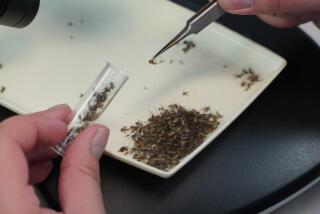INFECTIOUS DISEASE REPORT--SEPTEMBER
- Share via
Each week the Orange County Public Health Department reports to the state the incidence of various infectious diseases in the county. The following table details a selection of these afflictions.
NUMBER OF CASES Sept. Current Previous Disease 1988 Year to Date Year to Date Acquired immune deficiency 26 212 174 syndrome (AIDS) Campylobacter 24 227 270 Lapse of consciousness 123 1,249 1,220 (non-alcohol related) Giardiasis 38 315 307 Gonococcal infection 171 2,098 2,748 Hepatitis A 12 250 256 Hepatitis B 14 263 464 Meningitis 18 158 306 Salmonellosis 30 267 276 Shigellosis 73 277 177 Streptococcal infection 237 2,888 1,852 Syphilis 61 935 643 Tuberculosis 10 164 214
Year-to-Date % Disease Change, ‘87-’88 Acquired immune deficiency +22 syndrome (AIDS) Campylobacter -16 Lapse of consciousness +2 (non-alcohol related) Giardiasis +3 Gonococcal infection -24 Hepatitis A -2 Hepatitis B -43 Meningitis -48 Salmonellosis -3 Shigellosis +56 Streptococcal infection +56 Syphilis +45 Tuberculosis -23
Sources: Orange County Public Health Department, “Reported Cases of Specified Notifiable Diseases,” for September, 1988.
Acquired immune deficiency syndrome: Fatal disease that attacks the body’s immune system. Is caused by the human immunodeficiency virus. Transmitted by sexual contact, exposure to contaminated blood and from an infected mother to her newborn.
Campylobacter: Characterized by sudden, acute diarrhea, abdominal pain, fever and vomiting. Associated with foods poorly refrigerated or improperly cooked, unpasteurized milk and unchlorinated water.
Giardiasis: A protozoan infection principally of the upper small intestine. May be associated with a variety of intestinal symptoms, such as chronic diarrhea, abdominal cramps and bloating, fatigue and weight loss. Contracted by ingesting contaminated food or water.
Gonococcal infections: Sexually transmitted bacterial diseases that differ in males and females in terms of course, severity and recognition.
Hepatitis A: An acute viral illness affecting the liver. Occurs mostly in children and young adults. Usually transmitted by oral ingestion of infected material or by poor sanitation.
Hepatitis B: An acute illness of the liver transmitted by exposure
to contaminated needles, by administration of blood or blood products and/or oral ingestion of contaminated material.
Meningitis: Inflammation of the three membranes enveloping the brain and spinal chord.
Salmonellosis: A bacterial disease characterized by the sudden onset of a headache, abdominal pain, diarrhea, nausea, vomiting, dehydration and fever. Contracted by eating contaminated food.
Shigellosis: Acute diarrhea acquired by person-to-person contact, through eating contaminated food or by handling contaminated objects.
Streptococcal infection: Caused by a sphere-shaped bacterium and often manifested as strep throat or scarlet fever.
Syphilis: A chronic venereal disease transmitted by sexual intercourse. The first symptom, a chancre, appears after 12 to 30 days and is followed by a slight fever.
Tuberculosis: A mycobacterial disease that usually affects the lungs. General symptoms include sweats, hectic fever and severe weight loss.
More to Read
Sign up for Essential California
The most important California stories and recommendations in your inbox every morning.
You may occasionally receive promotional content from the Los Angeles Times.










